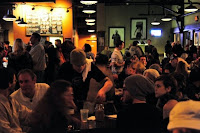
Festival expands with more collaboration and venues for Nov. 12-14 event in downtown Grand Rapids
GRAND RAPIDS, Mich., March 25, 2010 – Michigan Film Festival (MFF) announced today its second annual festival has been expanded to include additional collaborative partnerships and a new weekend for celebrating films made in Michigan.
The 2010 festival will be held Nov. 12-14 with a campus counting returning venues the Grand Rapids Art Museum (GRAM), scheduled to host panel discussions, lectures and family-friendly workshops; and the Urban Institute for the Contemporary Arts (UICA), for the Production Workshop and film screenings. New this year, Grand Valley State University’s downtown Pew Campus will screen student and faculty works in the Loosemoore Auditorium and ACTIVESITE @ 40 Monroe serves as the hospitality lounge and host site for the Music Supervisor’s Showcase.
The nonprofit Michigan Film Festival will feature screenings, lectures, workshops, panel discussions and receptions, with events for film lovers, film educators and filmmakers. A kick-off party is planned for Friday evening, Nov. 12. The complete schedule is being finalized and will be posted in the coming months at www.michiganfilmfest.org.
Festival theme: Harvesting Films in Michigan
The new dates also fit with the theme selected for the second annual festival: Harvesting Films in Michigan.
“With the passage of the film incentives in our state and the investments our community is making – investments like transforming warehouses into studios and retraining workers – Michigan has sown the seeds for a thriving filmmaking industry,” Pider said. “It’s up to those who care about sustaining this industry to take it to the next level, and that’s what the Michigan Film Festival is all about.”
All of the films shown at the film festival are made in Michigan. Screenings consist of selections from a variety of Michigan-based festivals and universities by invitation. Additional submissions to the Michigan Film Festival are accepted through the Mitten Map Film Competition (submitters are encouraged to visit MichiganFilmFest.org for competition guidelines).
Venues expand opportunities
The Grand Rapids Art Museum again serves as a venue too. “GRAM embraces diverse forms of artistic expression in its programming and event schedule, and the art of filmmaking is no exception,” said Festival Co-Founder Kerri VanderHoff, director of public relations and marketing for GRAM. “The festival’s focus on education and accessibility are especially important to the mission of GRAM, and we’ll offer workshops, panel discussions, lectures and more as part of the Art Museum’s participation as a venue for the Michigan Film Festival.”
UICA Public Relations Manager and Festival Co-Founder Phil Meade said the new UICA building opening at the southwest corner of Fulton and Division will feature two film theatres, a beautiful space for the production workshop and a dynamic array of contemporary art exhibits.
GVSU’s downtown campus is planned to be the host site for workshops geared toward those in film education – professors, teachers, trainers – anyone who educates others in the art and craft of filmmaking.
“The addition of GVSU opens up the event to really encompass downtown Grand Rapids – and it expands our ability to offer more to filmmakers, film educators and film goers,” said John Harper Philbin, associate professor of film and video production at GVSU. At last year’s inaugural Michigan Film Festival, Philbin directed the production workshop and screened his feature film To Live and Die in Dixie. Philbin serves on the festival’s programming committee.
Todd Ernst, who runs ACTIVESITE, is on board to provide ACTIVESITE @ 40 Monroe as a hospitality lounge and host site for a Music Supervisor’s Showcase of Michigan musicians seeking to promote their music for local film projects. “Hosting Michigan musicians is all part of encouraging the use of local talent on the soundtracks of Michigan-made movies,” Ernst said.
###
About the Michigan Film Festival
The mission of the Michigan Film Festival is to promote the Michigan perspective in film along with the Michigan filmmaking community by sustaining an event that includes educational workshops, panel discussions and lectures; exhibition venues displaying recently crafted Michigan-made works; and partnerships between local entities involved in supporting the Michigan film industry. Michigan Film Festival is organized by Pider Enterprises in partnership with GRAM, UICA, GVSU, ACTIVESITE and WMFVA. MFF Co-Founders: Jen Pider, Kerri VanderHoff, Chuck Peterson, Josh Depenbrok, Phil Meade, Matt Fulk and Justin Godley.
Additional contacts:
For questions specific to GRAM, please contact Kerri VanderHoff, 616-831-2914
For questions specific to UICA, please contact Phil Meade, 616-454-7000 x19
For questions specific to GVSU and its film program, please contact John Philbin, 616-331-3668
For questions specific to ACTIVESITE, please contact Todd Ernst, 616-805-9240





